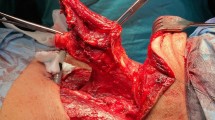Abstract
The formation of pharyngo-cutaneous fistula (PCF) is controversial and various predisposing factors have been proposed. This study aimed to compare different suture materials in the closure of pharyngeal wounds in experimental animals. Fifty-two Sprague-Dawley rats were divided into three groups. Artificial pharyngotomy was performed and was then repaired with Vicryl, polypropylene, and Vicryl plus fibrin glue, respectively. Outcome measurements included gross wound inspection and histological examination. There was a significant difference in the rates of PCF formation between group I and group II (Fisher’s exact test, p = 0.046). In addition, minimal inflammatory response was found in the polypropylene group when compared to the other groups. The fibrin glue-treated group had the highest fibroblast activity and collagen deposition. Polypropylene produced minimal tissue reaction, which facilitated the healing process. Therefore, proper selection of suture material can probably reduce the rate of PCF but should not be substituted for proper aseptic and meticulous surgical techniques.

Similar content being viewed by others
References
Soylu L, Kiroglu M, Aydogan B et al (1998) Pharyngocutaneous fistula following laryngectomy. Head Neck 20:22–25
Redaelli de Zinis LO, Ferrari L, Tomenzoli D, Premoli G, Parrinello G, Nicolai P (1999) Postlaryngectomy pharyngocutaneous fistula: incidence, predisposing factors, and therapy. Head Neck 21:131–138
Qureshi SS, Chaturvedi P, Pai PS et al (2005) A prospective study of pharyngocutaneous fistulas following total laryngectomy. J Can Res Ther 1:51–56
Sarkar S, Mehta SA, Tiwari J, Mehta AR, Mehta MS (1990) Complications following surgery for cancer of the larynx and pyriform fossa. J Surg Oncol 43:245–249
Man DW, Tang MY, Li AK (1998) End-to-end oesophageal anastomosis: an experimental study in the rat. Aust N Z J Surg 58:975–978
Lyons MB, Lyons GD, Webster D, Wheeler VR (1989) Adhesives in larynx repair. Laryngoscope 99:376–381
Matthews TW, Briant TD (1991) The use of fibrin tissue glue in thyroid surgery: resource utilization implications. J Otolaryngol 20:276–278
Philips JD, Kim CS, Fonkalsrud EW, Zeng H, Dindar H (1992) Effects of chronic corticosteroids and vitamin A on the healing of intestinal anastomoses. Am J Surg 163:71–77
Kanellos I, Odisseos C, Kazantizidou D, Galovatsea K, Zaraboukas T, Dadoukis I (1998) Effects of early vs. delayed postoperative injection of 5-fluorouracil plus interferon alpha on colonic healing. Eur Surg Res 30:414–418
Turan M, Saraydyn SU, Bulut HE et al (2004) Do vascular endothelial growth factor and basic fibroblast growth factor promote phenytoin’s wound healing effect in rats: an immunohistochemical and histopathologic study. Dermatol Surg 20:1303–1309
Singer AJ, Clark RA (1999) Cutaneous wound healing. N Engl J Med 341:738–746
de Melo GM, Ribeiro KC, Kowalski LP, Deheinzelin D (2001) Risk factors for postoperative complications in oral cancer and their prognostic implications. Arch Otolaryngol Head Neck Surg 127:828–833
Zabrodsky M, Calabrese L, Tosoni A et al (2004) Major surgery in elderly head and neck cancer patients: immediate and long-term surgical results and complication rates. Surg Oncol 13:249–255
Rhys-Evans PH (1989) Complications in head and neck surgery and how to avoid trouble. J Laryngol Otol 103:926–929
Grandis JR, Vickers RM, Rihs JD et al (1994) The efficacy of topical antibiotic prophylaxis for contaminated head and neck surgery. Laryngoscope 104:719–724
Balbuena L, Stambaugh KI, Ramirez SG, Yeager C (1998) Effects of topical oral antiseptic rinses on bacterial counts of saliva in healthy human subjects. Otolaryngol Head Neck Surg 118:625–9
Moy RL, Waldman B, Hein DW (1992) A review of sutures and suturing techniques. J Dermatol Surg Oncol 18:785–95
Beauchamp PJ, Guzick DS, Held B, Schmidt WA (1988) Histologic response to microsuture materials. J Reprod Med 33:615–623
Olutoye OO, Zhu X, Cass DL, Smith CW (2005) Neutrophil recruitment by fetal porcine endothelial cells: implications in scarless fetal wound healing. Pediatr Res 58:1290–1294
Ueno M, Lyons BL, Burzenski LM et al (2005) Accelerated wound healing of alkali-burned corneas in MRL mice is associated with a reduced inflammatory signature. Invest Ophthalmol Vis Sci 46:4097–4106
Kanellos I, Mantzoros I, Demetriades H et al (2004) Healing of colon anastomoses covered with fibrin glue after immediate postoperative intraperitoneal administration of 5-fluorouracil. Dis Colon Rectum 47:510–515
Weiss LS, Miller RH, Bates ML, Fisher E, Weiner N, Shepard D (1993) An animal model for pharyngocutaneous fistulas. Otolaryngol Head Neck Surg 108:738–742
Acknowledgments
This work was supported by grants from Taichung Veterans General Hospital (TCVGH-947002A) Taichung, Taiwan, Republic of China. No potential conflict of interest was involved in this research. The authors thank Ms. Hui-Ching Ho for statistical consulting.
Author information
Authors and Affiliations
Corresponding author
Rights and permissions
About this article
Cite this article
Liu, SA., Tung, KC., Cheng, CC. et al. The impact of different closure materials on pharyngeal wound healing: an experimental animal study. Eur Arch Otorhinolaryngol 265, 227–231 (2008). https://doi.org/10.1007/s00405-007-0431-9
Received:
Accepted:
Published:
Issue Date:
DOI: https://doi.org/10.1007/s00405-007-0431-9




